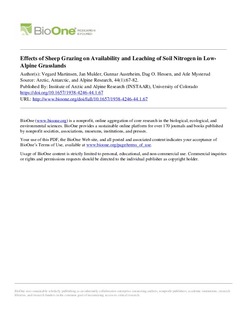Effects of Sheep Grazing on Availability and Leaching of Soil Nitrogen in Low-Alpine Grasslands
Journal article, Peer reviewed
Published version
Permanent lenke
http://hdl.handle.net/11250/2467498Utgivelsesdato
2012Metadata
Vis full innførselSamlinger
- Institutt for naturhistorie [1225]
- Publikasjoner fra CRIStin - NTNU [38070]
Originalversjon
Arctic, Antarctic and Alpine research. 2012, 44 (1), 67-82. 10.1657/1938-4246-44.1.67Sammendrag
Alpine ecosystems are generally nitrogen (N) limited with low rates of N mineralization. Herbivory may affect N cycling and N losses and thus long-term productivity of ecosystems.
Using a controlled grazing experiment in a low-alpine region at Hol, southern Norway, with three density levels of sheep, we determined effects of grazing on in situ availability of inorganic N, potential N mineralization, and mobility of dissolved inorganic N (DIN) and dissolved organic N (DON) in soil water of O-horizons in grazing-preferred grassland habitats. In addition, we studied the within-season and spatial variation of these processes.
The low alpine grasslands at Hol were characterized by small rates of N mineralization and relatively large plant demands for N. Significantly greater rates of potential N mineralization were found at sites with high sheep density compared to those with low density or no grazing. Effects of grazing on bioavailable N (as determined by buried PRS™ exchange resins) were greater at low as compared to high altitudes. At low altitudes, low sheep density reduced amounts of bioavailable N. Nitrogen concentration of plants as a proxy of N availability in soils revealed, however, no significant effects of grazing. There was a strong seasonal effect on inorganic N and DIN∶DON ratios of the soil water, with decreasing values in the course of the growing season, probably due to increasing nutrient demand of plants and/or microbes.
We conclude that grazing may significantly stimulate N-cycling, but not sufficiently to release the system from its strong N deficiency, as we found no evidence for short-term increased risk in N loss via soil water due to herbivore activity. Nitrogen removal through grazing is small compared to the total soil N pool and at high sheep density is about half of the N deposition. This suggests that grazing in grassland habitats in this low alpine ecosystem is sustainable from a nutrient point of view.
